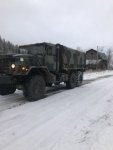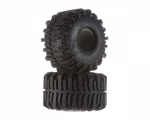You pretty much answered your own question. Follow the logic here...
Wet/icy roads have less friction. Normally you stop the truck by creating friction at the brakes, assuming that the tires will stay stuck to the road, and thus aren't a factor. But when the driving surface is slick, the tires lose traction to the road long before the brakes can do their work, so you are no longer stopping the truck with brakes... you are doing it with the friction of the tires sliding over the road surface (and that friction can be nearly zero). Compared to a smaller vehicle, heavy vehicles like an FMTV have a lot more inertia to dissipate, so once you start sliding, you are going to slide a lot further.
Your primary solution is to increase the friction of the tires to the driving surface. That means softer rubber compound (not many choices of tires, though), siping, and chains. (Any other options? The Autosock is interesting, but basically "chains" too.)
Adding weight to the truck does two things, trying to increase the mass that the coefficient of friction is being multiplied by, and trying to change the weight distribution of the vehicle. That's a lot harder to do when the these trucks weigh 18k+ pounds to start with, instead of 4000lb. As you add weight, in the quantities necessary to effect an 18,000lb truck, you're adding a lot more mass that you have to stop with that poor tire-to-road friction (e.g. adding stopping distance).
Another conclusion of the above is that: always keep in mind that you will be better off the road than on it, in these slippery conditions. When I'm driving in the LMTV, way more than in my Jeep/etc, if anything starts to slip at all and I have an opportunity to drive off the side of the road, I'm going to take it. Putting a pair of tires off the shoulder (obviously assuming there is nothing there to hit) will have way more traction and control than on a smooth, paved, wet/ice surface. Similarly, don't drive in the tracks of other vehicles that are compacted/worn down to pavement, drive in the deep parts of the snow (which would clog the treads of smaller vehicles' tires and cause them problems, but not you).
View attachment 854766
Snowy & icy roads only offer <25% of the tire-to-road friction. You're not going to win that game with smooth rubber tread blocks the size of candy bars in contact with the road.







